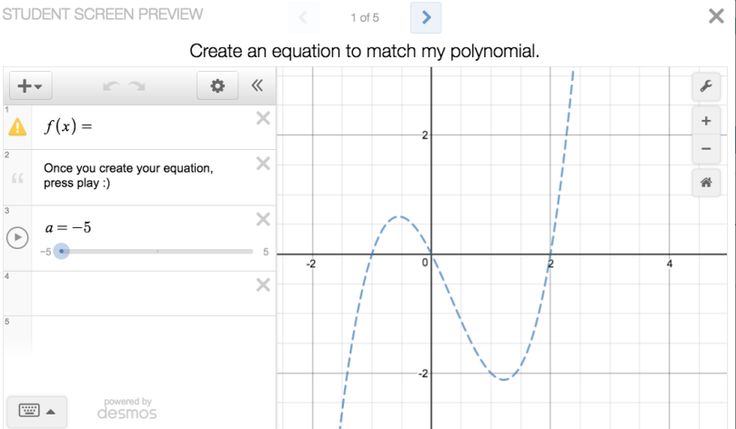How To Graph Polynomial Functions On Desmos
In addition, underneath the wrench icon, you should be able to see a + and a − icon. Here, we will explore the effects that changing the parameters.

Graphing Polynomial Project [Water Park] Polynomials
Intro to end behavior of polynomials (8:09)

How to graph polynomial functions on desmos. This page help you to explore polynomials of degrees up to 4. The graph setting menu in desmos. Check your work on the applet:
Solve for a, b, and c. Graphing a polynomial function helps to estimate local and global extremas. Starting from the left, the first zero occurs at \ (x=−3\).
Interpreting the angles in either degree or radian. To build the polynomial, start with the factors and their multiplicity. In this lesson we did an investigation using desmos, we looked at the relationship between the number of zeros and the degree of the polynomial function, we also looked at the relationship between the.
Videograph polynomial functionssketching the graph of a polynomial functiongraph of a polynomial functionuse the intermediate value theorem to help locate zeros of polynomial functions. Sectionsection 1section 2section 3section 4section 5section 6section 7. The polynomial function is of degree \ (n\).
In our example, one could make the assumption that the graph in the image represents some cubic polynomial since we can kind of see that it has a shape similar to this family of functions. The sum of the multiplicities must be \ (n\). To input the fraction , simply type 1/6 (then arrow over to end the fraction) and desmos will convert it to.
As the instructions state, students are to use desmos to try to make a polynomial graph that meets any of the described key features. Here we're using the assumption that the function crosses the origin, hence there is no. In this lesson, we covered the four types of transformations of a polynomial graph.
Desmos basics )using desmos, graph the function ( ( ). Given a polynomial function, sketch the graph. The zero of −3 has multiplicity 2.
Don't forget that these rules work for all polynomial functions, not just f(x) = x^2. Following this idea, we then want to find constants $a,b,c$ such that $$ f(x) = ax^3 + bx^2 + cx $$ observation: Find a polynomial equation in factored form for the graph’s function:
Identify zeros of polynomials when suitable factorizations are available, and use the zeros to construct a rough graph of the function defined by the polynomial. M and b have on the graph of the straight line f (x) =mx+b. To graph this function, type the equation as shown into box number 1 on the left.
Translation of cubic functions (teacher use) 3.2 end behavior of polynomial functions given a graph or equation. To graph polynomial functions, find the zeros and their multiplicities, determine the end behavior, and ensure that the final graph has at most \(n−1\) turning points. Use desmos to reproduce a version of this graph, including the scale of the axes and the
Applet polynomial functions roots and multiplicity of a polynomial 1. When they do, they copy and paste the desmos graph’s link in the blank cell, then highlight that cell to show they’ve completed it. Graphing a polynomial function helps to estimate local and global extremas.
A) the plot provided is for f (x) =1x +0 =x, so that m =1 and b =0.

Roller Coaster Project Algebra 2` Graphing functions

Factoring Trinomials SelfChecking Practice Activity

Made4Math Happy New Year! Polynomials, Teaching

Exponential Functions Transformations Poster

Marbleslides Parabolas Teaching math, Teaching, Algebra

Building Polynomials Coaster Edition High school math

Polynomial Evolution Teaching math, Algebra, Precalculus
Post a Comment for "How To Graph Polynomial Functions On Desmos"